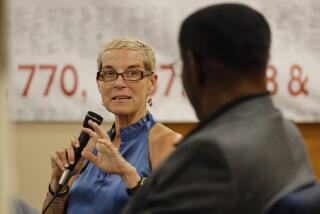Playing a key role in actors union merger
When members of Hollywood’s two biggest actors unions gathered at the National Labor College in Maryland last summer, it was hardly a love fest.
Representatives of the Screen Actors Guild and the American Federation of Television and Radio Artists were meeting to talk about merging their unions. But there was plenty of apprehension on both sides, given the years of turf wars and personality clashes that had caused a bitter fight between the unions in 2008.
Needing a mediator to help build trust and facilitate the delicate negotiations to combine two very different unions, SAG and AFTRA turned to Susan Schurman, a onetime bus driver and union leader turned academic who was the founding president of the AFL-CIO-sponsored National Labor College and was adept at training union officials.
Schurman had the union leaders perform a role-playing exercise: dividing them into groups in which they pretended to be family members who had to reach a consensus — about what kind of car they wanted to buy.
“It sounds simple and maybe even silly, but they’re performers so they really got into it,” said Schurman, acting dean of the Rutgers University’s School of Management and Labor Relations.
Beyond helping break the ice, the exercise also served as an introduction to a philosophy that Schurman teaches called “interest-based problem solving,” an alternative to the traditional zero-sum approach to negotiation. Rather than each side staking out a position, participants were encouraged to build consensus by examining their own interests and finding out what they have in common.
Working with her colleague, noted labor consultant Peter diCicco, Schurman applied the consensus-building approach to help SAG and AFTRA craft an agreement to merge their unions, whose boards overwhelmingly approved a plan last month that would create the largest entertainment guild in Hollywood, with more than 120,000 members. A minority of SAG board members who voted against the plan — including actors Ed Harris and Scott Bakula — issued an opposition statement, citing various criticisms, including the absence of an actuarial study on how a merger would affect health and pension plans.
The plan, which includes a proposed constitution and dues schedule for a new union dubbed SAG-AFTRA, will be voted on by members in the coming weeks. Referendum ballots will be mailed out next week and are due back March 30. The merger will take effect only if 60% of those who vote in each union agree to the plan.
Members of the so-called Group for One Union began formal merger talks more than six months ago. Citing the confidential nature of the proceedings, union leaders declined to discuss details of the meetings but nonetheless praised Schurman’s role in the talks.
“She and Pete really helped us learn and use this consensus-building process, which was really critical,” said AFTRA President Roberta Reardon. “There were difficult conversations, and many of us on both sides had strong opinions and positions that we didn’t want to give up. She wasn’t shy about telling me when I was going down the wrong road.”
SAG First National Vice President Ned Vaughn said: “Sue can come in a room, prick the balloon and let the air out so folks can relax and look past the need to lock into positions. She clearly had an understanding of the unique biases that each side would bring.”
Indeed, SAG and AFTRA have tried and failed several times in the past to merge, reflecting sharp differences in their cultures. SAG is a craft union that defines itself by representing a specific category of worker — actors. AFTRA, however, is more of a traditional industrial union that represents a wider variety of performers that not only includes actors but also singers, dancers and broadcast journalists.
Finding common ground would seem a daunting task for any facilitator, but Schurman is used to challenges.
The 64-year-old educator was raised in a small town in northern Michigan where her mother’s family ran a cherry farm and her grandfather mined for ore. She got her first taste of unionism from her father, a high school teacher and basketball coach who organized the first teachers union in their town after Michigan passed a collective-bargaining law for public-sector unions.
Schurman won a full scholarship to Michigan State University and was working on a master’s degree in higher education when she took time out to work as a bartender and later a bus driver for the Ann Arbor Transit Authority.
“I was 25 and one of six women bus drivers,” she recalled. “The men hated us.”
Undeterred, Schurman successfully ran for president of the local union and eventually became a director of driver training, marrying her interests in collective bargaining with employee education.
Schurman later returned to academia, earning graduate degrees in higher and continuing education from the University of Michigan. She joined Rutgers University as a labor studies professor and worked for 10 years at the National Labor College before returning to Rutgers in 2007. She was tapped by SAG and AFTRA in December 2010 because of her work helping other unions.
In the 1980s, she advised the United Auto Workers, using interest-based bargaining to help the union form a successful partnership with Ford Motor Co. that kept a plant from closing in Dearborn, Mich. A decade later, she worked with DiCicco to help a group of unions representing doctors, nurses, pharmacists and orderlies at Kaiser Permanente band together so they could form an effective coalition.
It confirmed a simple lesson: “Employers can’t have a partnership with labor if the unions can’t agree with each other,” she said.
More to Read
Inside the business of entertainment
The Wide Shot brings you news, analysis and insights on everything from streaming wars to production — and what it all means for the future.
You may occasionally receive promotional content from the Los Angeles Times.









